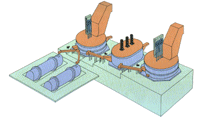
One of the most important principles of the
Mitsubishi Process is the simplicity
of its design, construction, operation and
maintenance;
Such simplicity on the design and construction
significantly reduces the
capital cost and man-power requirements for
the operation.
Sulfide copper ores are normally treated
in two stages; the matte making stage,(where
matte and slag are produced by smelting),
and the converting stage,(where iron and sulfur
in matte are progressively oxidized for the
production of blister copper). Although the
chemical reactions in both process steps
are oxidations, there is a significant difference
in the required oxygen potential. The first
stage is less oxidizing so that low copper
slag can be produced, while the second stage
is strongly oxidizing so that iron and sulfur
can be sufficiently removed from the blister.
These two quite distinct reaction conditions
can only be maintained efficiently
if each stage is performed in the respective
individual vessels (furnaces).
The Mitsubishi Process is a multi-furnace
system, each furnace performing
its respective function, thus optimizing
the reaction conditions in each
step of the process.
In addition to the above, the process is
distinct from conventional smelting methods
in that the matte grade can be raised up
to 65-69% while maintaining a low level of
copper loss in the discard slag. This feature
has made the reduction in the amount of slag
formed in the converting furnace to less
than 10% of the initial charge of concentrates
possible. Because of the reduced amount of
the converting furnace slag, returning this
slag to the smelting furnace has been greatly
simplified.
Ferrous calcium silicate (FCS) slag has been tried to use
at Ausmelt converter, but in this case the amount of slag
to be recycled to the smelting stage would be much larger
and it is not always economical.
Experiments into the use of tuyeres for the
injection of concentrates were
carried out in the initial stage of the development
work, but were abandoned
because of a limitation in the campaign life.
The application of lances,
which can be supplied without involving a
furnace shutdown, was then examined.
The lances used in steel-making LD converter
could not be applied directly
due to the fundamental differences between
steel-making and copper-making.
The development of lances suitable for the
Mitsubishi Process was then
carried out in accordance with the following
principles: (a) to be operable
with low pressure blast, (b) to have a simple
structure and (c) to be made
from inexpensive material easily available
in the market. After a series
of modifications and improvements, the lances
which satisfied these requirements
were successfully developed. The original
lances used in the pilot plant
were relatively small in diameter, but were
gradually increased to enlarge
the feeding capacity of each lance. The lance diameter affects
the amount of splash generated beneath lances, which may attack
the side wall. The estimation method of the splash amount was developed,
and by using that lance position can be arranged properly.
The nature of the Mitsubishi Process allows
for a more efficient capture of the offgas
stream. This produces a
rich stable SO2 offgas stream, resulting
in increased operating efficiency of the
acid plant which reduces SO2 and SO3 emissions.
Additionally, transportation of molten materials
such as matte, CL-slag, C-slag, and blister
consists of launders with covers made from
refractory thus minimizing gas emissions.
Also, critical areas such as furnace outlets
and launders have ventilation
hoods where the air is led through high-efficiency
baghouses to reduce
fugitive emissions.
One of the advantages of a continuous process
is that it enables a straightforward and
stable operation. Compared to other smelting
processes, the S furnace within the Mitsubishi
Process is able to continuously produce a
consistent amount and grade of matte, which
is continuously converted in the C furnace.
In conventional batch-wise converters, the
condition of the melt keeps changing constantly
with time and a lot of accumulated experience
is required to operate such furnaces. However,
by making the process continuous and keeping
the melt condition stable, such experience
is no longer vital in maintaining successful
operations, instead of which relatively inexperienced
operators are able to control the furnace.
Gresik is the first copper smelter and refinery in Indonesia,
and almost all Indonesian employee had no experience with its operation.
After the initial training and start-up assistance by Mitsubishi,
the smelter has been successfully operated by themselves. It proves the simplicity of the process control and operation..
In addition, a Computer Assisted Learning and Instruction System(CALIS), has been developed,
which will greatly assist operators new to the Mitsubishi process and will be an important
strategic tool in the export of the process
The development of the computer system (CALIS) including video manuals began to achieve the following goals: